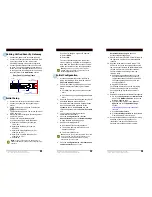
107
Glossary
Q
Quality of Service (QoS): Guarantees network bandwidth and availability for applications.
Quantizing: The process of analog-to-digital conversion by assigning a range, from the contiguous analog values, to a discrete number.
R
Random Access Memory (RAM): A computer's primary workspace. All data must be stored in RAM (even for a short while), before
software can use the processor to manipulate the data. Before a PC can do anything useful it must move programs from disk to RAM. When
you turn it off, all information in RAM is lost.
RAS Channel: An unreliable channel used to convey the Registration, Admissions and Status messages and bandwidth changes between
two H.323 entities.
Rate Enforcement: The concept in frame relay where frames sent faster than the CIR are to be carried only if the bandwidth is available,
otherwise they are to be discarded. (The frame relay network assumes that anything exceeding the CIR is of low priority.) Rate enforcement
makes sure that the network will not get so congested that it isn't able to meet the agreed on CIR
Recognized Private Operating Agency (RPOA): A corporation, private or government-controlled, that provides telecommunications
services. RPOAs, such as AT&T, participate as non-voting members in the CCITT.
Red Alarm: A T1 error condition generated when a local failure (e.g., loss of synchronization) exists for 2.5 seconds, causing a Carrier Group
Alarm (CGA). See also "Blue Alarm" and "Yellow Alarm".
Request for Comment (RFC): A set of papers in which Internet standards (published and proposed), along with generally-accepted ideas,
proposals, research results, etc. are published.
Ring Down Box: A device that emulates a CO by generating POTS calls for testing and product demos.
Ring Down Circuit: A tie line connecting phones where picking up one phone automatically rings another phone. A feature used for
emergencies to alert the person at the other phone of the incoming call.
RJ-11: An industry standard interface used for connecting a phone to a modular wall outlet; comes in 4-and 6-wire packages.
RJ-45: An 8-wire modular connector for voice and data circuits.
Robbed Bit Signaling: The popular T1 signaling mechanism where the A and B bits are sent by each side of the T1 termination and are
"buried" in the voice data of each voice channel in the T1 circuit. Since the bits are "robbed" infrequently, voice quality is remains relatively
uncompromised. See "bit robbing".
The robbed-bit signaling technique is used in D4 channel banks to convey signaling information. The eighth (least significant) bit of each of
the 24 8-bit time slots is "robbed" every sixth frame to convey voice-related signaling information such as on-hook, off-hook, etc., for each
channel.
Router: A device that connects two networks using the same networking protocol. It operates at the Network Layer (Layer 3) of the OSI
model for forwarding decisions.
Routing Information Protocol (RIP): A distance vector-based protocol that provides a measure of distance, or hops, from a transmitting
workstation to a receiving workstation.
RS-232-C: An EIA standard for a serial interface between computers and peripheral devices (modem, mouse, etc.). It uses a 25-pin DB-25,
or a 9-pin DB-9 connector. The RS-232 standard defines the purposes, electrical characteristics and timing of the signals for each of the 25
lines.
RS-422: The EIA standard for a balanced interface with no accompanying physical connector. RS-422 products can use screw terminals,
DB-9, various DB-25, and DB-37 connectors.
RS-530: The EIA standard for the mechanical/electrical interface between DCEs and DTEs transmitting synchronous or asynchronous serial
binary data. RS-530 provides for high data rates with the same connector used for RS-232; however, it is incompatible with RS-232.
S
Serial Port: The connector on a PC used to attach serial devices (those that need to receive data one bit after another), such as a mouse, a
printer or a modem. This consists of a 9- or 25-pin connector that sends data in sequence (bit by bit). Serial ports are referred to as "COMx"
ports, where x is 1 to 4 (i.e., COM1 through COM4). A serial port contains a conversion chip called a "UART" which translates between
internal parallel and external serial formats.
Service: The requirements offered by an RPOA to its customers to satisfy specific telecommunications needs.
Severely Errored Seconds (SES): Refers to a typical T1 error event where an error burst occurs (a short term, high bit-error rate that is
self-clearing). Per the ITU-T (CCITT) G.821: any second in which the BER is less than 1x10
-3
.
Содержание MultiVOIP 200 MVP200
Страница 1: ...Voice Fax over IP Networks Voice Fax Over IP Networks Model MVP200 H 323 Mode User Guide...
Страница 5: ...Voice Fax over IP Networks Chapter 1 Introduction and Description...
Страница 16: ...16 MultiVOIP 200 User Guide...
Страница 17: ...Voice Fax over IP Networks Chapter 2 Installation...
Страница 23: ...Voice Fax over IP Networks Chapter 3 Software Loading and Configuration...
Страница 51: ...Voice Fax over IP Networks Chapter 4 MultiVOIP 200 Software...
Страница 75: ...Voice Fax over IP Networks Chapter 5 Remote Configuration and Management...
Страница 83: ...Voice Fax over IP Networks Chapter 6 Warranty Service and Tech Support...
Страница 87: ...Voice Fax over IP Networks Appendixes...
Страница 96: ...96 MultiVOIP 200 User Guide...
Страница 97: ...Voice Fax over IP Networks Glossary...
Страница 113: ...113 Index...







































